A Multi-Stage Coordinated Volt-Var Optimization for Integrated and Unbalanced Radial Distribution Networks †
Abstract
:1. Introduction
- Proposing a joint VV control framework that covers unbalanced and integrated MV and LV distribution networks.
- Presenting a three-stage strategy that effectively coordinates traditional MV three-phase SCs (high capacity but discrete) and emerging LV single-phase PV inverters (low capacity but continuous).
- Formulating a multi-objective optimization model that improves the network operation in terms of voltage deviation, voltage unbalance and power loss, as well as the SC switching costs.
2. The Proposal
2.1. Proposed VV Optimization Formulation
2.2. Technical Constraints
2.3. Proposed Coordination Strategy
2.4. Required Computation and Communication
3. Problem Solution
4. Performance Evaluation
4.1. Test Network
4.2. Simulation Parameters and Cases
4.3. Simulation Results and Analyses
4.4. Sensitivity Analysis on Crtical Parameters
5. Performance Evaluation on Large Network
6. Conclusions and Future Work
Author Contributions
Funding
Conflicts of Interest
References
- Ganguly, S. Multi-Objective Planning for Reactive Power Compensation of Radial Distribution Networks with Unified Power Quality Conditioner Allocation Using Particle Swarm Optimization. IEEE Trans. Power Syst. 2014, 29, 1801–1810. [Google Scholar] [CrossRef]
- Tushar, M.H.K.; Assi, C. Volt-VAR Control Through Joint Optimization of Capacitor Bank Switching, Renewable Energy, and Home Appliances. IEEE Trans. Smart Grid 2017, 9, 4077–4086. [Google Scholar] [CrossRef]
- Spring, A.; Wirth, G.; Becker, G.; Pardatscher, R.; Witzmann, R. Grid Influences from Reactive Power Flow of Photovoltaic Inverters With a Power Factor Specification of One. IEEE Trans. Smart Grid 2015, 7, 1. [Google Scholar] [CrossRef]
- Liu, M.; Canizares, C.; Huang, W. Reactive Power and Voltage Control in Distribution Systems with Limited Switching Operations. IEEE Trans. Power Syst. 2009, 24, 889–899. [Google Scholar] [CrossRef]
- Zhang, L.; Tang, W.; Liang, J.; Cong, P.; Cai, Y. Coordinated Day-Ahead Reactive Power Dispatch in Distribution Network Based on Real Power Forecast Errors. IEEE Trans. Power Syst. 2015, 31, 2472–2480. [Google Scholar] [CrossRef]
- Ranamuka, D.; Agalgaonkar, A.P.; Muttaqi, K.M. Examining the interactions between DG units and voltage regulating devices for effective voltage control in distribution systems. IEEE Trans. Ind. Appl. 2017, 53, 1485–1496. [Google Scholar] [CrossRef]
- Barr, J.; Majumder, R. Integration of Distributed Generation in the Volt/VAR Management System for Active Distribution Networks. IEEE Trans. Smart Grid 2014, 6, 576–586. [Google Scholar] [CrossRef]
- Zheng, W.; Wu, W.; Zhang, B.; Wang, Y. Robust reactive power optimisation and voltage control method for active distribution networks via dual time-scale coordination. IET Gener. Transm. Distrib. 2017, 11, 1461–1471. [Google Scholar] [CrossRef] [Green Version]
- Dothinka, R.R.; Agalgaonkar, A.; Muttaqi, K. On-line voltage control in distribution systems with multiple voltage regulating devices. In Proceedings of the 2014 IEEE PES General Meeting | Conference & Exposition, National Harbor, MD, USA, 27–31 July 2014; Volume 5, p. 1. [Google Scholar] [CrossRef]
- Zhang, X.; Flueck, A.J.; Nguyen, C.P. Agent-Based Distributed Volt/Var Control with Distributed Power Flow Solver in Smart Grid. IEEE Trans. Smart Grid 2016, 7, 600–607. [Google Scholar] [CrossRef]
- Kim, Y.J.; Kirtley, J.L.; Norford, L.K. Reactive Power Ancillary Service of Synchronous DGs in Coordination with Voltage Control Devices. IEEE Trans. Smart Grid 2015, 8, 1. [Google Scholar] [CrossRef]
- Hong, Y.-Y.; Luo, Y.-F. Optimal VAR Control Considering Wind Farms Using Probabilistic Load-Flow and Gray-Based Genetic Algorithms. IEEE Trans. Power Deliv. 2009, 24, 1441–1449. [Google Scholar] [CrossRef]
- Viawan, F.; Karlsson, D. Voltage and Reactive Power Control in Systems with Synchronous Machine-Based Distributed Generation. IEEE Trans. Power Deliv. 2008, 23, 1079–1087. [Google Scholar] [CrossRef]
- Anilkumar, R.; Devriese, G.; Srivastava, A.K. Voltage and Reactive Power Control to Maximize the Energy Savings in Power Distribution System with Wind Energy. IEEE Trans. Ind. Appl. 2018, 54, 656–664. [Google Scholar] [CrossRef]
- Capitanescu, F.; Bilibin, I.; Romero-Ramos, E. A Comprehensive Centralized Approach for Voltage Constraints Management in Active Distribution Grid. IEEE Trans. Power Syst. 2013, 29, 933–942. [Google Scholar] [CrossRef] [Green Version]
- Wang, Z.; Wang, J.; Chen, B.; Begovic, M.M.; He, Y. MPC-Based Voltage/Var Optimization for Distribution Circuits with Distributed Generators and Exponential Load Models. IEEE Trans. Smart Grid 2014, 5, 2412–2420. [Google Scholar] [CrossRef]
- Su, X.; Wolfs, P.; Masoum, M.A. Comprehensive optimal photovoltaic inverter control strategy in unbalanced three-phase four-wire low voltage distribution networks. IET Gener. Transm. Distrib. 2014, 8, 1848–1859. [Google Scholar] [CrossRef]
- Su, X.; Masoum, M.A.S.; Wolfs, P. Multi-Objective Hierarchical Control of Unbalanced Distribution Networks to Accommodate More Renewable Connections in the Smart Grid Era. IEEE Trans. Power Syst. 2015, 31, 3924–3936. [Google Scholar] [CrossRef]
- Jabalameli, N.; Su, X.; Ghosh, A. Online Centralized Charging Coordination of PEVs With Decentralized Var Discharging for Mitigation of Voltage Unbalance. IEEE Power Energy Technol. Syst. J. 2019, 6, 152–161. [Google Scholar] [CrossRef]
- Wang, T.; Meskin, M.; Su, X.; Grinberg, I.; Wang, Z. Optimal inverter based distributed generation units control strategy to improve voltage profiles in unbalanced distribution networks. IET Gener. Transm. Distrib. 2019, 13, 4910–4921. [Google Scholar] [CrossRef]
- Su, X.; Masoum, M.A.S.; Wolfs, P. Optimal PV Inverter Reactive Power Control and Real Power Curtailment to Improve Performance of Unbalanced Four-Wire LV Distribution Networks. IEEE Trans. Sustain. Energy 2014, 5, 967–977. [Google Scholar] [CrossRef]
- Su, X.; Liu, J.; Fu, Y.; Mi, Y.; Shahnia, F. An Efficient Joint Coordination of Volt-Var Support in Medium and Low Voltage Distribution Feeders. In Proceedings of the 2019 IEEE International Conference on Industrial Technology (ICIT), Melbourne, Australia, 13–15 February 2019; pp. 1668–1672. [Google Scholar]
- Kersting, W.H. Distribution System Modeling and Analysis; CRC Press: Boca Raton, FL, USA, 2011. [Google Scholar]
- Pillay, P.; Manyage, M. Definitions of voltage unbalance. IEEE Power Eng. Rev. 2001, 21, 50–51. [Google Scholar] [CrossRef]
- Marler, R.T.; Arora, J.S. Weighted sum method for multi-objective optimization: New sights. Struc. Multidiscip. Optim. 2010, 41, 853–862. [Google Scholar] [CrossRef]
- Industrial Controllers, National InstrumentsTM Website. 2017. Available online: http://www.ni.com/industrial-controller (accessed on 12 October 2019).
- Intel Hardware, Software and Technologies for Industrial Automation, Intel® Website. 2017. Available online: https://www-ssl.intel.com/content/www/us/en/industrial-utomation/products-and-solutions/hardware-software-technologies.html (accessed on 16 May 2020).
- Process Control and Industrial Automation, Analog DevicesTM Website. 2017. Available online: http://www.analog.com/en/applications/markets/process-control-and-industrial-automation.html (accessed on 26 November 2019).
- Gungor, V.C.; Sahin, D.; Kocak, T.; Ergut, S.; Buccella, C.; Cecati, C.; Hancke, G. A Survey on Smart Grid Potential Applications and Communication Requirements. IEEE Trans. Ind. Inform. 2012, 9, 28–42. [Google Scholar] [CrossRef] [Green Version]
- Del Valle, Y.; Venayagamoorthy, G.; Mohagheghi, S.; Hernandez, J.-C.; Harley, R.G. Particle Swarm Optimization: Basic Concepts, Variants and Applications in Power Systems. IEEE Trans. Evol. Comput. 2008, 12, 171–195. [Google Scholar] [CrossRef]
- Yan, Y.; Qian, Y.; Sharif, H.; Tipper, D. A Survey on Smart Grid Communication Infrastructures: Motivations, Requirements and Challenges. IEEE Commun. Surv. Tutor. 2013, 15, 5–20. [Google Scholar] [CrossRef] [Green Version]
- Arefi, A.; Abeygunawardana, A.M.A.K.; Ledwich, G. A New Risk-Managed Planning of Electric Distribution Network Incorporating Customer Engagement and Temporary Solutions. IEEE Trans. Sustain. Energy 2016, 7, 1646–1661. [Google Scholar] [CrossRef]
- Ziari, I.; Ledwich, G.; Ghosh, A. Optimal distribution network reinforcement considering load growth, line loss and reliability. IEEE Trans. Power Syst. 2013, 28, 1. [Google Scholar] [CrossRef]
- Teng, J.-H. A direct approach for distribution system load flow solutions. IEEE Trans. Power Deliv. 2003, 18, 882–887. [Google Scholar] [CrossRef]
- Anwar, A.; Mahmood, A.N.; Taheri, J.; Tari, Z.; Zomaya, A. HPC based Intelligent Volt/VAr Control of Unbalanced Distribution Smart Grid in the presence of Noise. IEEE Trans. Smart Grid 2017, 8, 1. [Google Scholar] [CrossRef]
- City, P.S. Perth Solar City Annual Report; Western Power: Perth, Australia, 2012. [Google Scholar]
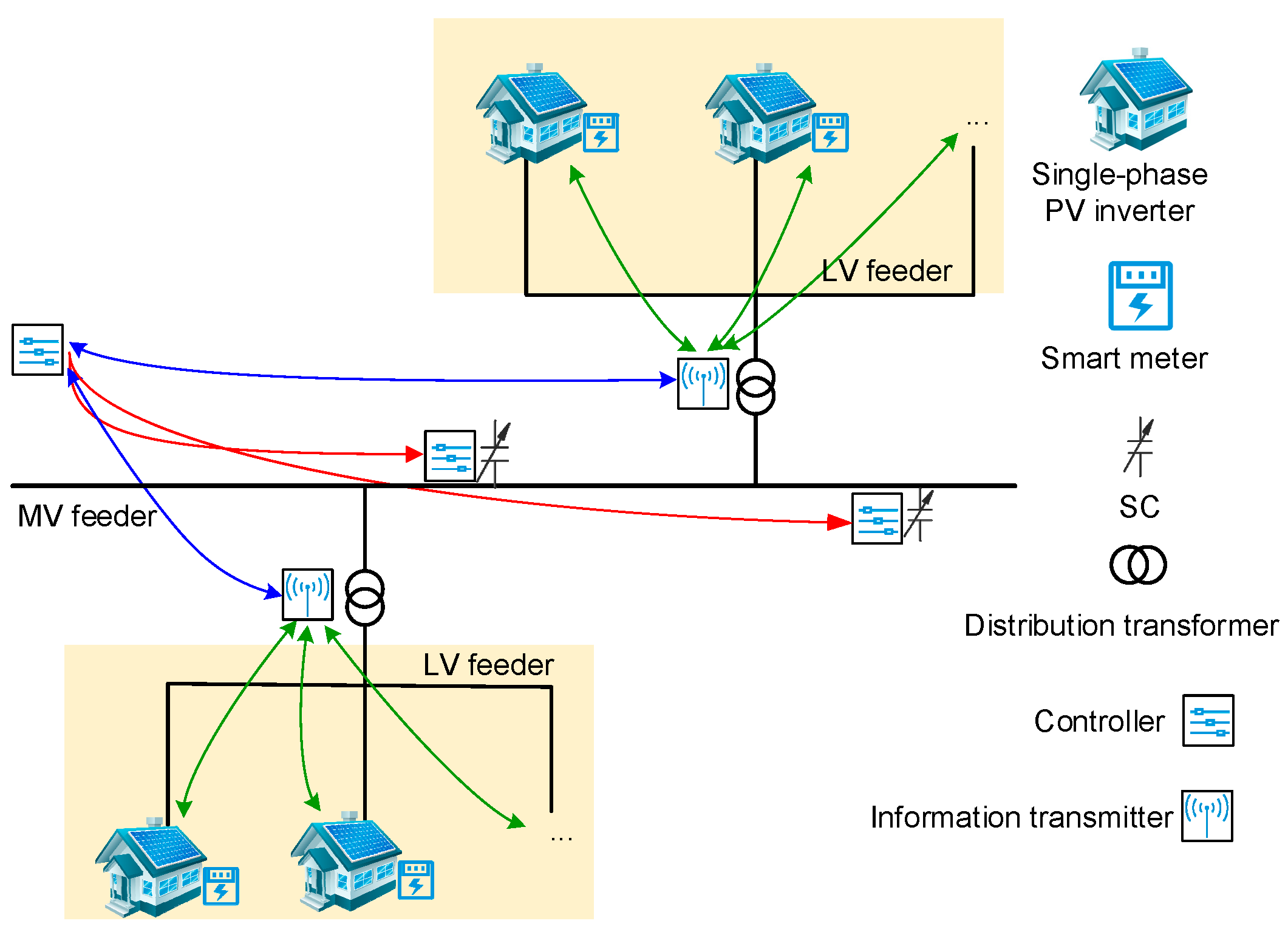
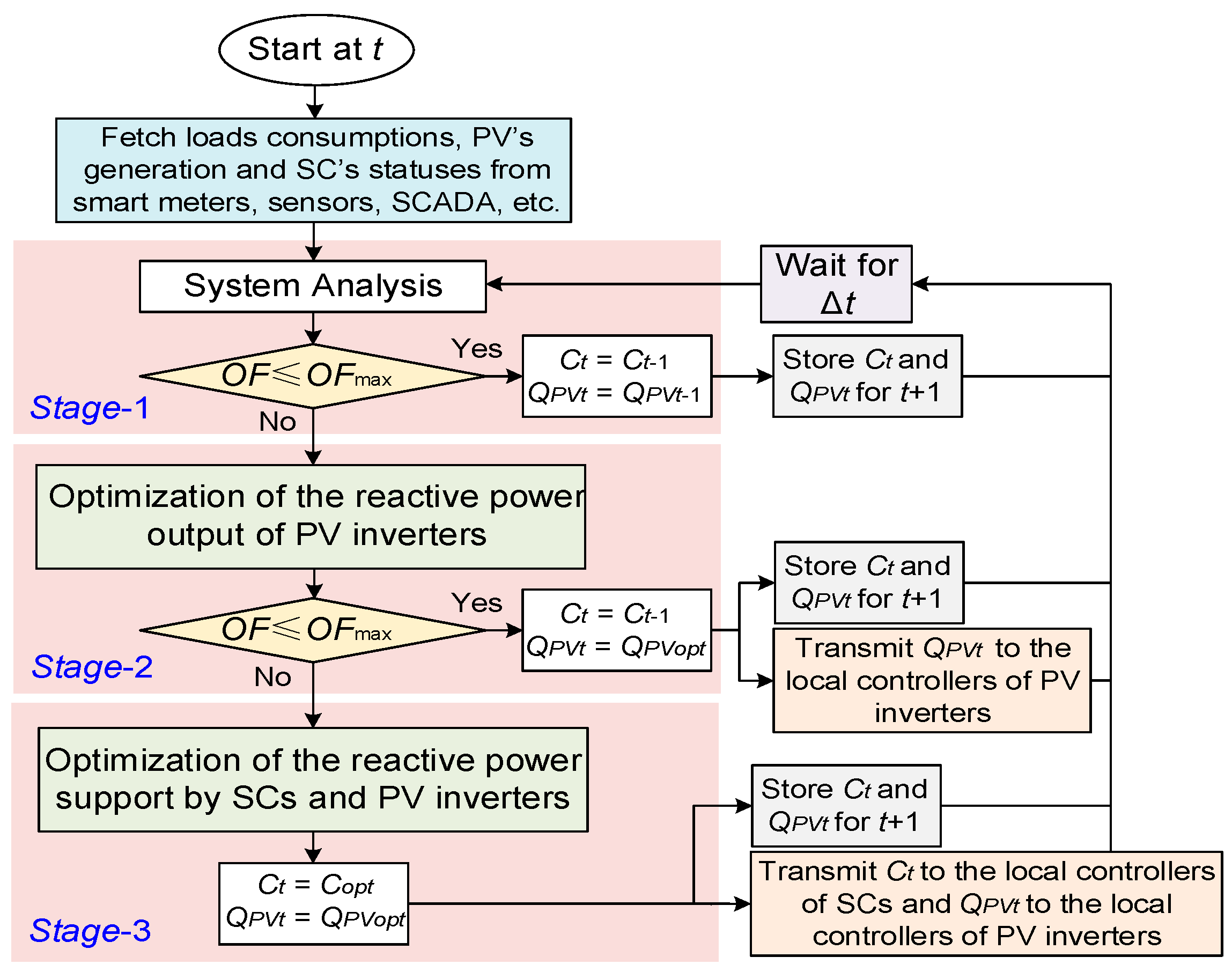


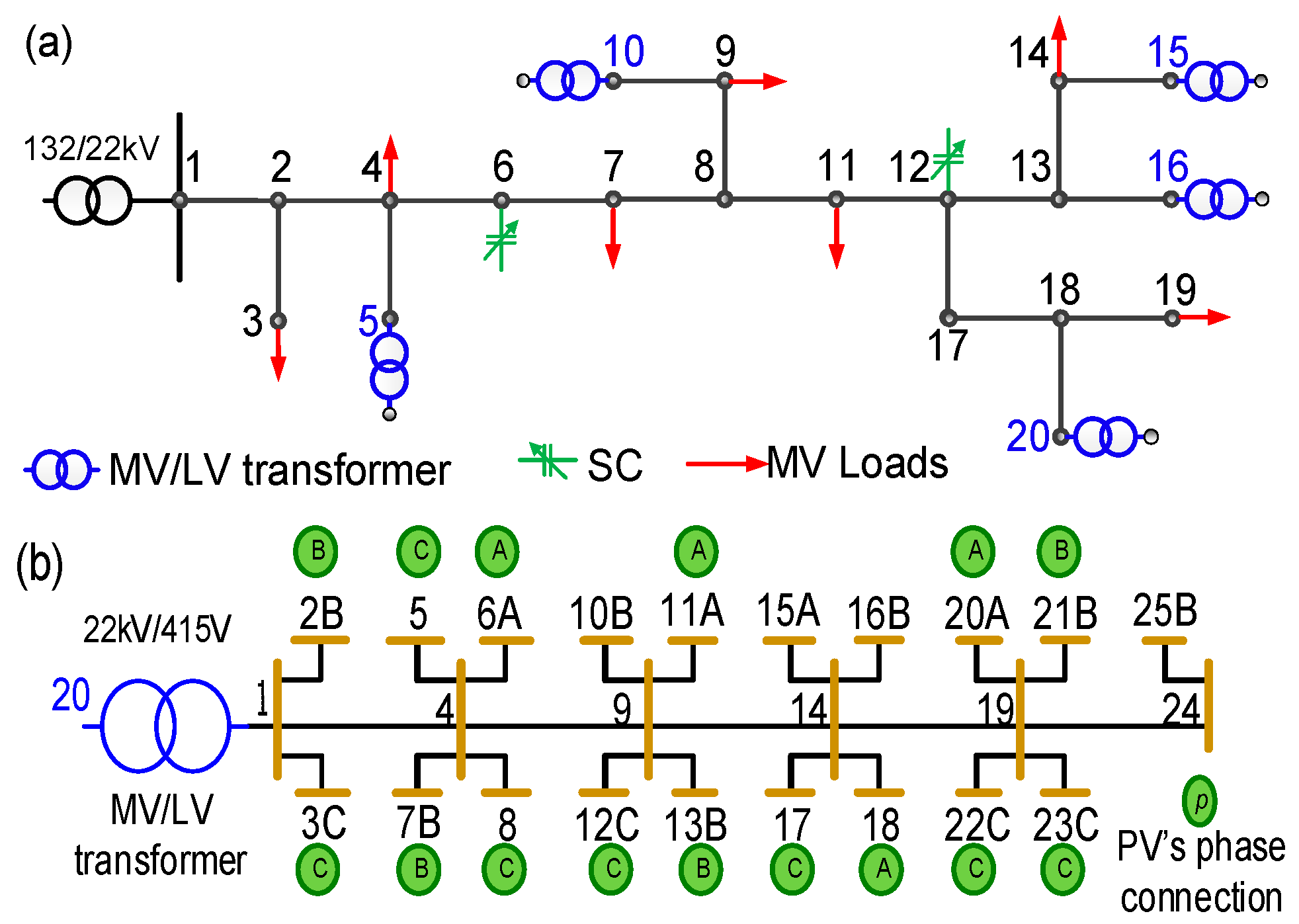
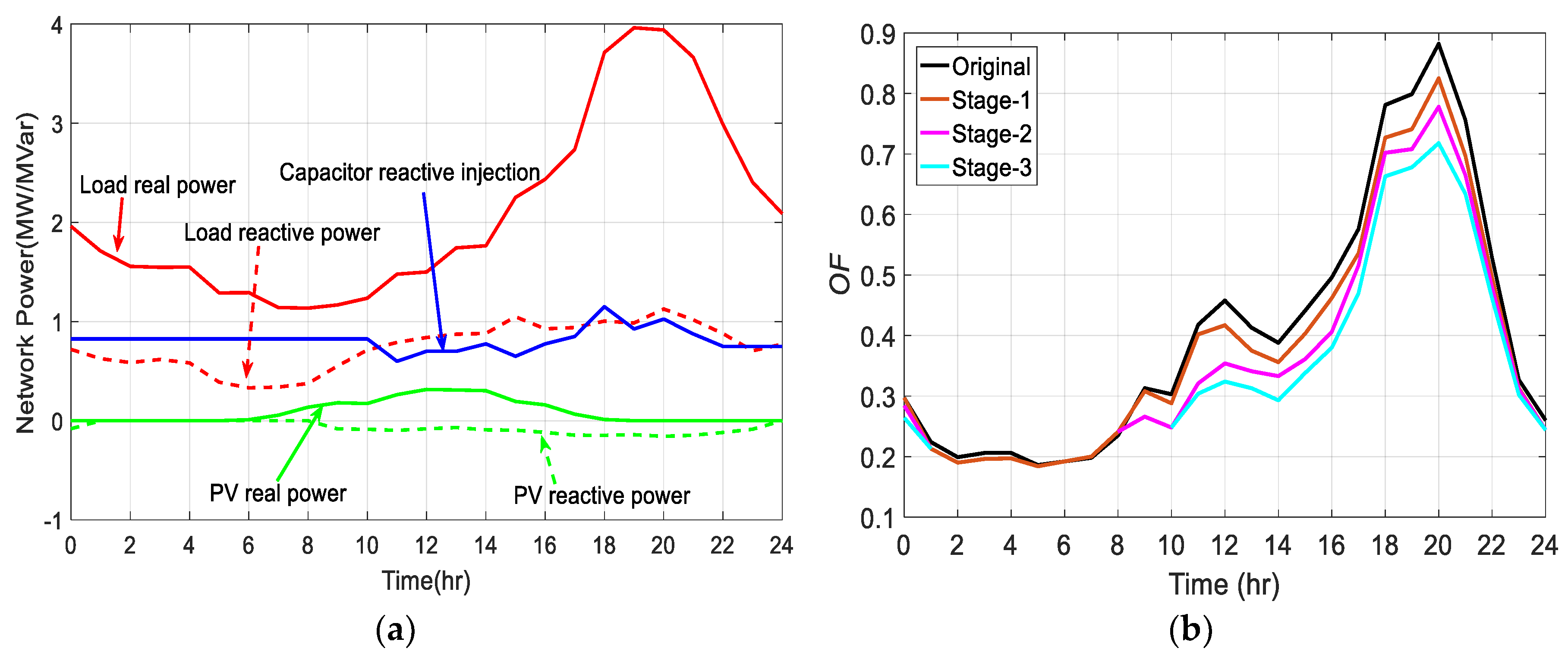

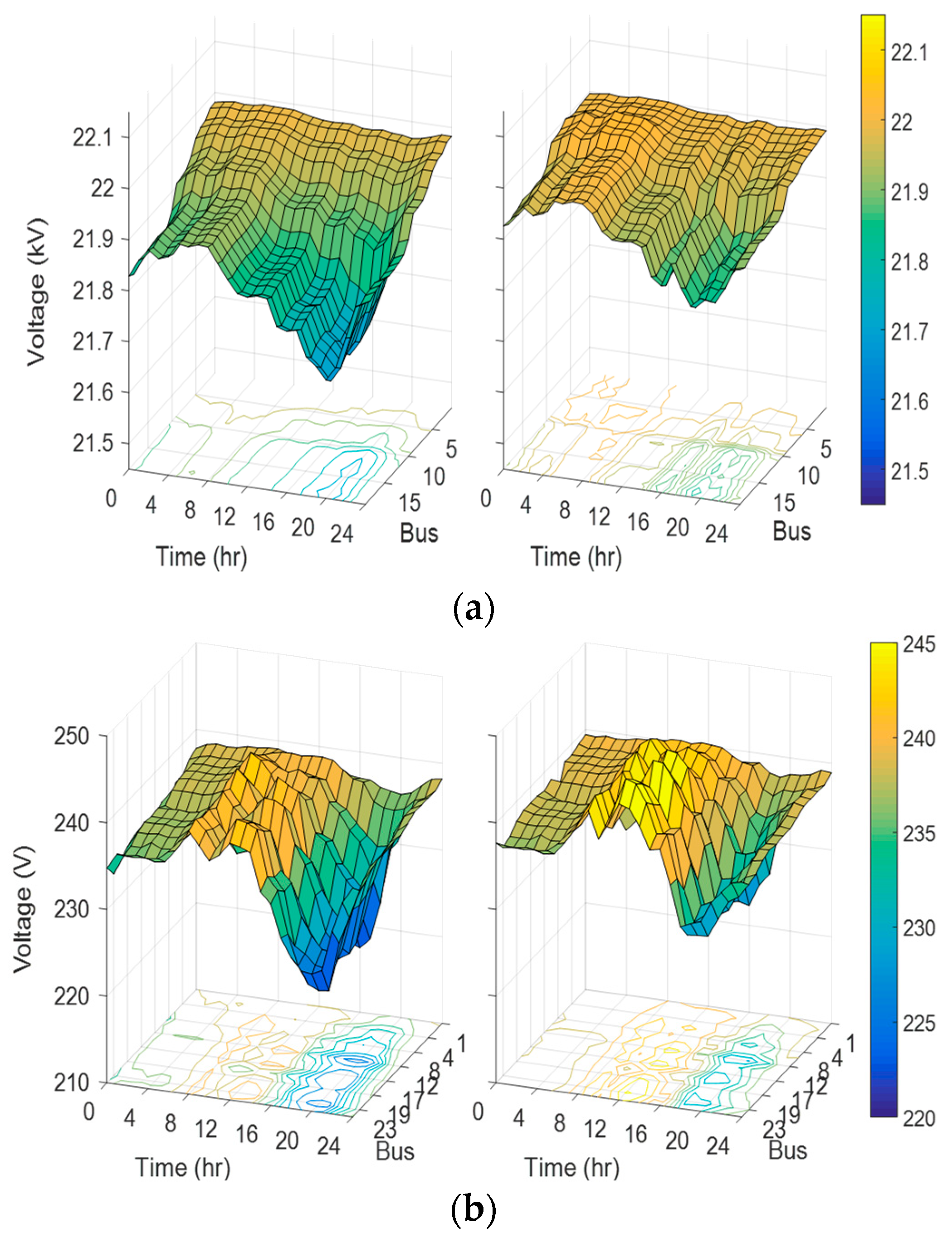

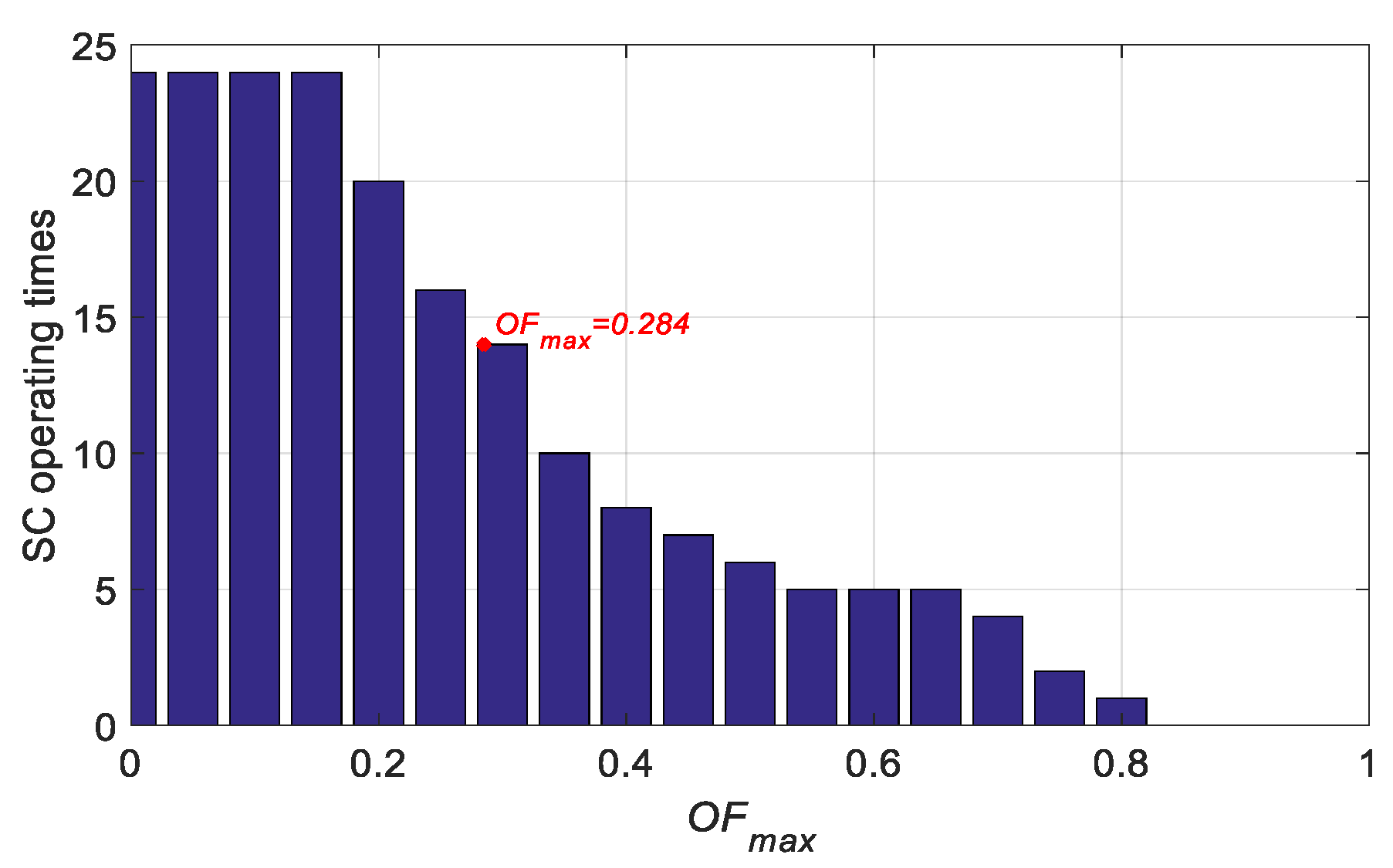
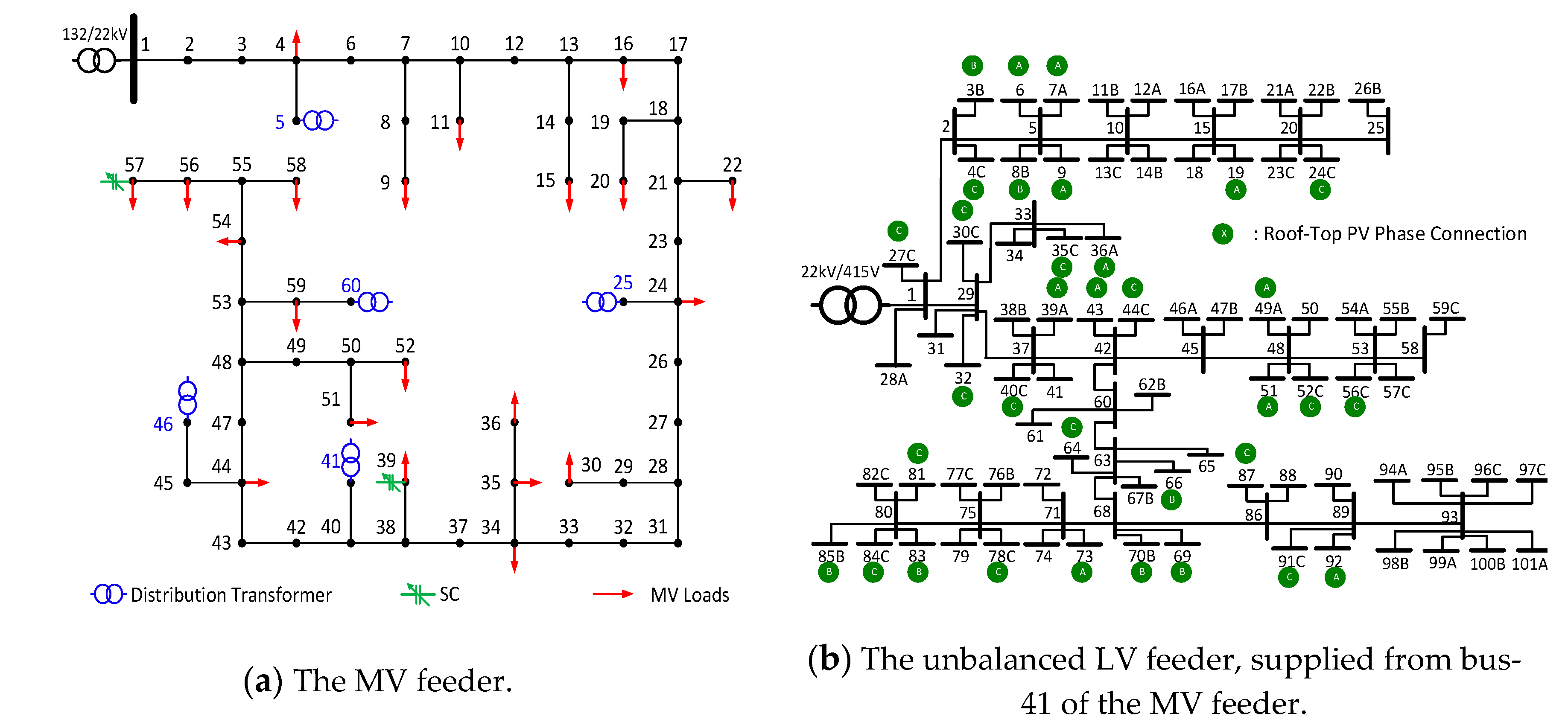
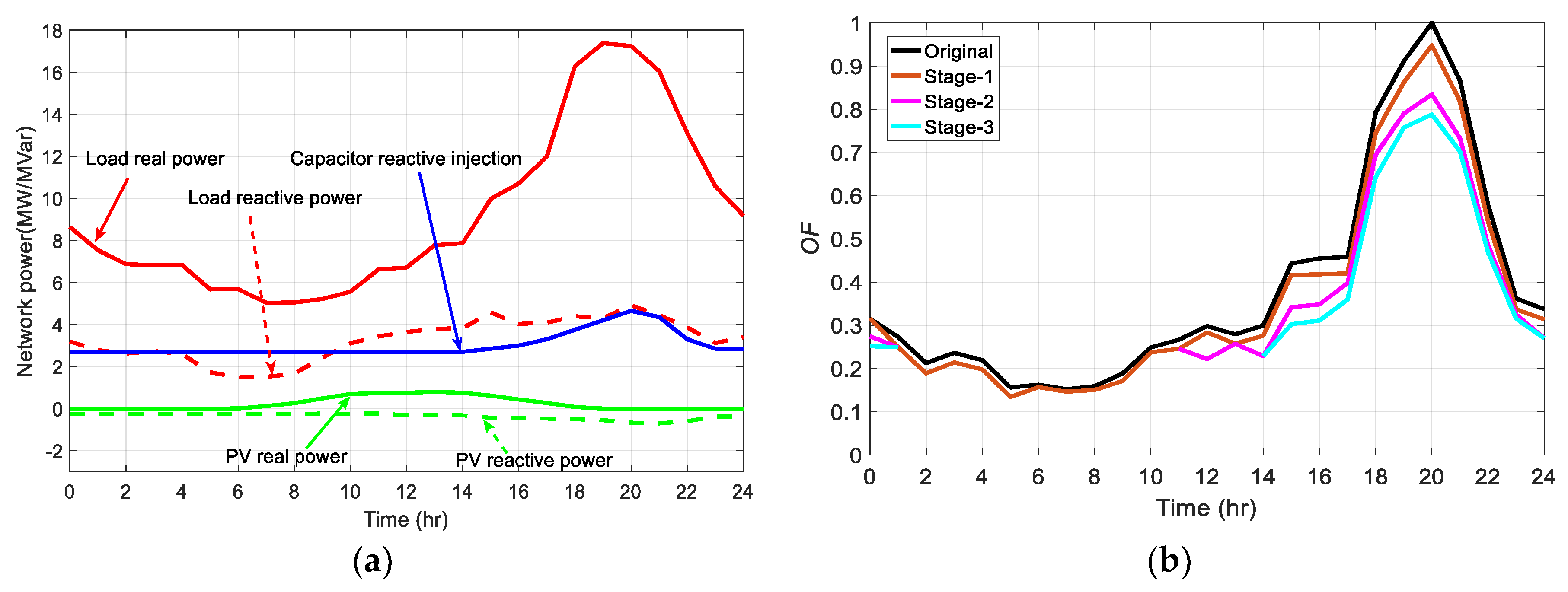
| Ref. | Control | Voltage Level | Network Balance | Day-Ahead/Real-Time | Considered Objectives | ||||||||
|---|---|---|---|---|---|---|---|---|---|---|---|---|---|
| Centralized | Decentralized | MV | LV | Balanced | Unbalanced | Day-Ahead | Quasi- Real-Time | Real-Time | Voltage Magnitude | Voltage Unbalance | Power Loss | Switching Costs | |
| [5] | ✓ | ✓ | ✓ | ✓ | ✓ | ✓ | ✓ | ||||||
| [6] | ✓ | ✓ | ✓ | ✓ | ✓ | ||||||||
| [7] | ✓ | ✓ | ✓ | ✓ | ✓ | ||||||||
| [8] | ✓ | ✓ | ✓ | ✓ | ✓ | ✓ | |||||||
| [9] | ✓ | ✓ | ✓ | ✓ | ✓ | ✓ | |||||||
| [10] | ✓ | ✓ | ✓ | ✓ | ✓ | ✓ | ✓ | ||||||
| [11] | ✓ | ✓ | ✓ | ✓ | ✓ | ✓ | ✓ | ||||||
| [12] | ✓ | ✓ | ✓ | ✓ | ✓ | ✓ | |||||||
| [13] | ✓ | ✓ | ✓ | ✓ | ✓ | ✓ | ✓ | ||||||
| [14] | ✓ | ✓ | ✓ | ✓ | ✓ | ✓ | |||||||
| [15] | ✓ | ✓ | ✓ | ✓ | ✓ | ✓ | |||||||
| [16] | ✓ | ✓ | ✓ | ✓ | ✓ | ✓ | |||||||
| [17] | ✓ | ✓ | ✓ | ✓ | ✓ | ✓ | ✓ | ✓ | |||||
| [18] | ✓ | ✓ | ✓ | ✓ | ✓ | ✓ | ✓ | ✓ | ✓ | ||||
| [19] | ✓ | ✓ | ✓ | ✓ | ✓ | ✓ | |||||||
| [20] | ✓ | ✓ | ✓ | ✓ | ✓ | ✓ | ✓ | ✓ | |||||
| [21] | ✓ | ✓ | ✓ | ✓ | ✓ | ✓ | ✓ | ✓ | |||||
| This paper | ✓ | ✓ | ✓ | ✓ | ✓ | ✓ | ✓ | ✓ | ✓ | ||||
| Time (h) | Before Applying the Proposed Technique | After Applying the Proposed Multi-Stage Technique | |||||||||||||||||
|---|---|---|---|---|---|---|---|---|---|---|---|---|---|---|---|---|---|---|---|
| Original Case | Stage 1 | Stage 2 | Stage 3 | ||||||||||||||||
| 00 | 0.245 | 0.402 | 0.270 | 0.297 | ✕ | 0.245 | 0.402 | 0.27 | 0.297 | ✕ | 0.239 | 0.380 | 0.252 | 0.285 | ✕ | 0.233 | 0.324 | 0.251 | 0.264 |
| 01 | 0.146 | 0.344 | 0.242 | 0.224 | ✓ | 0.139 | 0.312 | 0.249 | 0.213 | ✓ | -- | -- | -- | -- | -- | -- | -- | -- | -- |
| 02 | 0.113 | 0.325 | 0.226 | 0.199 | ✓ | 0.111 | 0.295 | 0.232 | 0.190 | ✓ | -- | -- | -- | -- | -- | -- | -- | -- | -- |
| 03 | 0.118 | 0.330 | 0.241 | 0.206 | ✓ | 0.112 | 0.299 | 0.249 | 0.196 | ✓ | -- | -- | -- | -- | -- | -- | -- | -- | -- |
| 04 | 0.118 | 0.334 | 0.233 | 0.206 | ✓ | 0.114 | 0.303 | 0.242 | 0.197 | ✓ | -- | -- | -- | -- | -- | -- | -- | -- | -- |
| 05 | 0.088 | 0.315 | 0.239 | 0.186 | ✓ | 0.096 | 0.288 | 0.247 | 0.184 | ✓ | -- | -- | -- | -- | -- | -- | -- | -- | -- |
| 06 | 0.091 | 0.312 | 0.262 | 0.192 | ✓ | 0.103 | 0.286 | 0.272 | 0.192 | ✓ | -- | -- | -- | -- | -- | -- | -- | -- | -- |
| 07 | 0.084 | 0.302 | 0.326 | 0.198 | ✓ | 0.094 | 0.284 | 0.339 | 0.200 | ✓ | -- | -- | -- | -- | -- | -- | -- | -- | -- |
| 08 | 0.099 | 0.312 | 0.457 | 0.241 | ✓ | 0.106 | 0.311 | 0.473 | 0.235 | ✓ | -- | -- | -- | -- | -- | -- | -- | -- | -- |
| 09 | 0.164 | 0.355 | 0.635 | 0.313 | ✕ | 0.158 | 0.339 | 0.654 | 0.308 | ✕ | 0.151 | 0.323 | 0.437 | 0.266 | ✓ | -- | -- | -- | -- |
| 10 | 0.171 | 0.364 | 0.54 | 0.303 | ✕ | 0.167 | 0.336 | 0.556 | 0.288 | ✕ | 0.152 | 0.305 | 0.367 | 0.248 | ✓ | -- | -- | -- | -- |
| 11 | 0.249 | 0.394 | 0.898 | 0.418 | ✕ | 0.222 | 0.371 | 0.876 | 0.402 | ✕ | 0.221 | 0.350 | 0.528 | 0.321 | ✕ | 0.209 | 0.352 | 0.467 | 0.304 |
| 12 | 0.276 | 0.402 | 1 | 0.458 | ✕ | 0.256 | 0.384 | 0.911 | 0.417 | ✕ | 0.239 | 0.363 | 0.585 | 0.354 | ✕ | 0.240 | 0.362 | 0.475 | 0.324 |
| 13 | 0.271 | 0.395 | 0.795 | 0.413 | ✕ | 0.252 | 0.366 | 0.733 | 0.375 | ✕ | 0.236 | 0.366 | 0.527 | 0.341 | ✕ | 0.231 | 0.356 | 0.452 | 0.313 |
| 14 | 0.260 | 0.382 | 0.714 | 0.388 | ✕ | 0.236 | 0.354 | 0.681 | 0.356 | ✕ | 0.227 | 0.357 | 0.538 | 0.333 | ✕ | 0.219 | 0.343 | 0.406 | 0.293 |
| 15 | 0.366 | 0.491 | 0.557 | 0.441 | ✕ | 0.345 | 0.445 | 0.54 | 0.403 | ✕ | 0.322 | 0.372 | 0.387 | 0.361 | ✕ | 0.316 | 0.392 | 0.311 | 0.338 |
| 16 | 0.423 | 0.562 | 0.58 | 0.496 | ✕ | 0.411 | 0.516 | 0.57 | 0.462 | ✕ | 0.386 | 0.474 | 0.292 | 0.406 | ✕ | 0.397 | 0.414 | 0.288 | 0.380 |
| 17 | 0.577 | 0.711 | 0.406 | 0.576 | ✕ | 0.563 | 0.638 | 0.397 | 0.536 | ✕ | 0.531 | 0.549 | 0.312 | 0.516 | ✕ | 0.529 | 0.499 | 0.279 | 0.470 |
| 18 | 0.881 | 0.898 | 0.377 | 0.781 | ✕ | 0.873 | 0.792 | 0.357 | 0.727 | ✕ | 0.836 | 0.683 | 0.284 | 0.702 | ✕ | 0.852 | 0.608 | 0.271 | 0.663 |
| 19 | 0.927 | 0.882 | 0.356 | 0.799 | ✕ | 0.914 | 0.757 | 0.348 | 0.741 | ✕ | 0.889 | 0.649 | 0.282 | 0.708 | ✕ | 0.888 | 0.606 | 0.264 | 0.678 |
| 20 | 1.000 | 1.000 | 0.412 | 0.882 | ✕ | 0.993 | 0.888 | 0.434 | 0.825 | ✕ | 0.944 | 0.749 | 0.287 | 0.778 | ✕ | 0.944 | 0.643 | 0.267 | 0.718 |
| 21 | 0.835 | 0.847 | 0.422 | 0.756 | ✕ | 0.821 | 0.738 | 0.41 | 0.697 | ✕ | 0.788 | 0.643 | 0.306 | 0.665 | ✕ | 0.808 | 0.590 | 0.268 | 0.634 |
| 22 | 0.556 | 0.618 | 0.368 | 0.528 | ✕ | 0.539 | 0.556 | 0.372 | 0.496 | ✕ | 0.510 | 0.488 | 0.27 | 0.479 | ✕ | 0.535 | 0.465 | 0.269 | 0.461 |
| 23 | 0.304 | 0.421 | 0.265 | 0.327 | ✕ | 0.296 | 0.386 | 0.282 | 0.313 | ✕ | 0.283 | 0.370 | 0.237 | 0.311 | ✕ | 0.302 | 0.340 | 0.246 | 0.302 |
| 24 | 0.191 | 0.368 | 0.268 | 0.260 | ✓ | 0.178 | 0.338 | 0.267 | 0.244 | ✓ | -- | -- | -- | -- | -- | -- | -- | -- | -- |
| Group | Group 1 | Group 2 | Group 3 | ||||||
|---|---|---|---|---|---|---|---|---|---|
| Case | Before Control | After Control | Reduction (%) | Before Control | After Control | Reduction (%) | Before Control | After Control | Reduction (%) |
| 1.000 | 0.667 | 33.3 | 1.000 | 0.978 | 2.2 | 1.000 | 0.977 | 2.3 | |
| 1.000 | 0.933 | 6.7 | 1.000 | 0.646 | 35.4 | 1.000 | 0.858 | 14.2 | |
| 0.412 | 0.311 | 24.5 | 0.412 | 0.393 | 4.6 | 0.412 | 0.257 | 37.6 | |
© 2020 by the authors. Licensee MDPI, Basel, Switzerland. This article is an open access article distributed under the terms and conditions of the Creative Commons Attribution (CC BY) license (http://creativecommons.org/licenses/by/4.0/).
Share and Cite
Su, X.; Liu, J.; Tian, S.; Ling, P.; Fu, Y.; Wei, S.; SiMa, C. A Multi-Stage Coordinated Volt-Var Optimization for Integrated and Unbalanced Radial Distribution Networks. Energies 2020, 13, 4877. https://doi.org/10.3390/en13184877
Su X, Liu J, Tian S, Ling P, Fu Y, Wei S, SiMa C. A Multi-Stage Coordinated Volt-Var Optimization for Integrated and Unbalanced Radial Distribution Networks. Energies. 2020; 13(18):4877. https://doi.org/10.3390/en13184877
Chicago/Turabian StyleSu, Xiangjing, Jining Liu, Shuxin Tian, Ping Ling, Yang Fu, Shurong Wei, and Chao SiMa. 2020. "A Multi-Stage Coordinated Volt-Var Optimization for Integrated and Unbalanced Radial Distribution Networks" Energies 13, no. 18: 4877. https://doi.org/10.3390/en13184877





